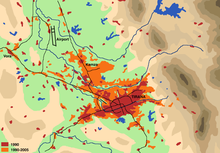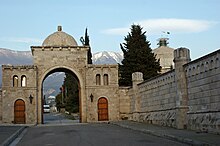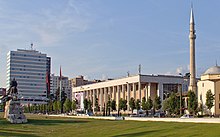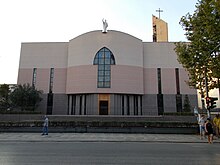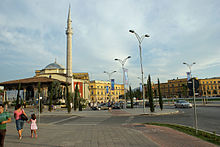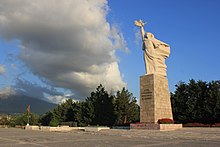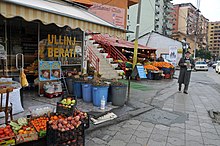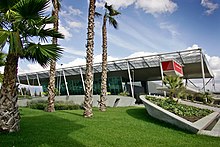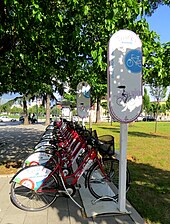Tirana
|
Tiranë Tirana |
||

|
||
|
Coordinates: 41 ° 20 ' N , 19 ° 49' E |
||
| Basic data | ||
|---|---|---|
| Qark : | Tirana | |
| Municipality : | Tirana | |
| Height : | 110 m above sea level A. | |
| Area : | 1,110.03 km² | |
| Residential place : | 418,495 (2011) | |
| Bashkia residents : | 557,422 (2011) | |
| Agglomeration : | 895.042 | |
| Population density (Bashkia): | 502 inhabitants / km² | |
| Telephone code : | (+355) 04 | |
| Postal code : | 1001-1028 | |
| Politics and administration (as of 2019 ) | ||
| Structure : | 25 administrative units | |
| Mayor : | Erion Veliaj ( PS ) | |
| Website : | ||
| Culture and history | ||
| Local place name : | Tiron / Tirona | |
| City foundation : | 1614 | |
| City Festival : | November 17th (Liberation Day) | |
 View over the city from the south with the Great Park and the artificial lake in the foreground and the Dajti in the background (2015) |
||
Tirana [ tiɾana ] (specific names shape, indeterminate: Tiranë [ tiɹan ]; in the local gegischen dialect Tirona [ tiɹɔna ] or Tiron [ tiɹɔn ]) is the capital of Albania . In the 2011 census, 418,495 inhabitants were recorded for the city and 557,422 inhabitants for today's municipality. According to its own information, Tirana has significantly more, around 625,000 inhabitants (2009), while the agglomeration has 895,042 inhabitants (2008). With Durrës and a few suburbs, Tirana forms a metropolitan region , where the largest airport and port in Albania are also located.
Tirana is the cultural, political and economic center of a centrally organized state and the seat of several institutions, organizations and parties. So there is the parliament and the government of the country . Tirana is the capital of the Qark of the same name and, until its dissolution, was also the capital of a district , a large part of which today belongs to the territory of the Bashkia (municipality).
geography
Geographical location
Tirana is located at the western foot of its local mountain Dajti ( 1611 m above sea level ) at the transition from the plain to the hilly landscape at an altitude of 110 m above sea level. A. in central Albania. It is only about 30 kilometers as the crow flies to the coast of the Adriatic Sea near the port city of Durrës - the second largest city in the country. In the south and west, Tirana is surrounded by hills, which with the Dajti form a green belt around the city. To the northwest, a plain about 40 kilometers long opens up to the sea coast.
The Tirana River , one of the upper reaches of the Ishëm River , runs on the northern outskirts of the city . A few kilometers south of the ore flows past Tirana. The city center is crossed by the Lana River, which has its source on Dajti.
The area around the capital is characterized by many small, partly artificial lakes. The most famous is Lake Tirana , also known as the artificial lake (Liqeni artificial) . It is located in the Great Park (Parku i madh) on the southern edge of the city center and was created in 1956. At that time, eight square meters of park area were calculated for each of the 150,000 residents. The lake has an area of 55 hectares. It is bordered on the southern edge by new settlements and a section of the motorway.
Other lakes or reservoirs are Lake Farka east of the Great Park, Lake Paskuqan between Tirana and the suburb of Kamza and Lake Kashar northwest of the city near the town of the same name on the Tirana – Durrës motorway.
Outside the city center, large hilly and mountainous areas - a large part of the old Tirana district - also belong to the municipality.
City structure

2: Qytet Studenti , Sauk ; 3: Xhamllëku ;
4: Babrruja , Allias , Kinostudio ; 5: Selita , Tirana e Re ;
6: Combine , Yzberisht ; 7: Ish-Fusha e Aviacionit (old airfield), 21 Dhjator ;
8: Selvia , Medreseja ; 9: Brraka , Don Bosko ;
10: center; 11: Lapraka , Institute , Don Bosko
The old municipality of Tirana was only divided into eleven districts (officially Albanian Njësi administrative or also called Minibashki ), each of which had its own mayor and was subordinate to the mayor.
Since the community reform in 2015, the previously independent communities Baldushk, Bërzhita , Dajt , Farka , Kashar , Krraba , Ndroq, Petrela , Peza, Shëngjergj, Vaqarr, Zall-Bastar and Zall-Herr have been added to Bashkia Tirana. The mayor now determines the administrators in the individual districts.
climate
Tirana is located in the Mediterranean climate zone . According to Köppen, the city has a humid , subtropical climate ( effective climate classification : Cfa).
Summers are warm and often hot; the winters are cool, but the daytime temperature rarely drops below freezing point. The warmest month is July with 24.9 ° C, the coldest January with an average of 7 ° C. Due to the geographical location in a valley basin , it is often a few degrees warmer in Tirana than in the surrounding countryside. The average annual temperature is 15.9 ° C.
The mean annual rainfall is 1265 millimeters. It is due to the effect of the Skanderbeggebirge , which dammed the westerly winds. In summer, the precipitation falls mainly as heavy rain , so that despite above-average amounts of precipitation, a lot of sunny days are recorded. In November there is the most precipitation with an average of 172 millimeters, in July with an average of 42 millimeters the lowest (according to other sources in July even only 29 millimeters).
Very often an inversion weather situation occurs in the big city , which leads to high air pollution and smog .
| Tirana | ||||||||||||||||||||||||||||||||||||||||||||||||
|---|---|---|---|---|---|---|---|---|---|---|---|---|---|---|---|---|---|---|---|---|---|---|---|---|---|---|---|---|---|---|---|---|---|---|---|---|---|---|---|---|---|---|---|---|---|---|---|---|
| Climate diagram | ||||||||||||||||||||||||||||||||||||||||||||||||
| ||||||||||||||||||||||||||||||||||||||||||||||||
|
Average monthly temperatures and rainfall for Tirana
Source: wetter.de ; wetterkontor.de
|
|||||||||||||||||||||||||||||||||||||||||||||||||||||||||||||||||||||||||||||||||||||||||||||||||||||||||||||||||||||||||||||||||||||||||||||||||||||||||||||||||||||
history
Earliest references and city foundation
The area around Tirana has been inhabited since the Paleolithic . The oldest finds in the city are from Roman times : walls and a mosaic from a Roman villa from the 2nd or 3rd century that was converted into a church. In the 6th century, the Roman Emperor Justinian I had a fortress built, the walls of which can still be seen in the city center.
Tirana was first mentioned in its current name in Venetian documents in 1372 and 1418 . In 1431/32 the Ottomans carried out a registration of soils and inhabitants in the area for the first time. According to this, there were 60 villages with around 1000 houses and 7300 inhabitants in this region. Marin Barleti made a distinction in the 16th century between Tyranna maior (Greater Tirana) and Tyranna Minor (Little Tirana) . In 1583, an Ottoman census for the Tirana area revealed 110 localities in which 20,000 people lived in 2900 houses.
The local landowner Sulejman Pascha Bargjini , who comes from Mullet near Petrela , built the Sylejman Pascha mosque , a caravanserai (Han) , a bakery and a hammam on the current site in 1614 and is therefore considered the founder of the city of Tirana. Presumably a small place with a regular bazaar and fair existed at this point, which had gained in importance, which is why it was worthwhile to build such an infrastructure for the traveling traders. After Sulejman's descendants died out around 1800, the Toptani family from Kruja took control of Tirana.
Determination of the capital in 1920 and first urban development measures
Tirana remained small and insignificant for a long time until the town was designated the capital of Albania at the Lushnja Congress in 1920 . A place with a few thousand inhabitants quickly became the largest and most important city in the country. King Zogu had a palace built here and, with Italian help, ministries and a boulevard were laid out. The first modern structures emerged through urban development measures, including the central square named after the Albanian Prince Skanderbeg .
Dictatorship from 1944 to 1990/91
At the beginning of the Second World War in 1939, Albania was occupied by the Italian fascists .
In November 1941, Enver Hoxha established the Communist Party of Albania in Tirana , and Tirana became the center of the Albanian communists . They campaigned among the population to fight against the Italian fascists and the German Nazis . The city was liberated on November 17, 1944 after a difficult battle between the partisans and the Wehrmacht that lasted several days , in which numerous historical buildings - including the most important mosque - were destroyed. A few days later, on November 29, 1944, Hoxha proclaimed Albania's independence in Tirana.
During the time of communist rule , the city developed rapidly: socialist housing estates and factories - especially food and machine factories - were built. In addition, the communist leadership continued the cultural expansion of the capital and built numerous educational institutions and cultural centers such as the opera house , several museums, the film studio and some theaters. The University of Tirana was founded in 1956.
In order to be able to redesign the center of the city, numerous historical buildings were destroyed in the 1960s and 1980s.
Time of democratization
On February 20, 1991, protesters overturned the larger than life statue of Enver Hoxha in Skanderbeg Square . Thus the end of communist rule was initiated. Albania gradually began to open up and to democratize politically and socially. In March 1997 Albania was again shaken by unrest . Foreigners had to be flown out, for example in Operation Libelle by the Bundeswehr .
After the democratization, the cityscape changed quickly. Illegal buildings were being erected everywhere, especially to the northwest. Many residents of the rural regions settled on the outskirts. Shops, cafes and restaurants have sprung up in the city center. From 1999 the illegal buildings in the city center were torn down and the green spaces restored.
Tirana experienced an economic boom in the 21st century. Numerous modern high-rise buildings have emerged. Most of the streets have been re-paved and signposted. Many parks have been set up and many trees have been planted. A city and regulatory plan has been completed. A sewerage project is being carried out by a Japanese company and large parts of the city have been cleaned up. International companies and shops opened branches. Public transport has been partially expanded and new city buses have been purchased. A tram project is being examined. An address system was also implemented.
On the night of September 21 to September 22, 2019, Tirana was shaken by an earthquake. The quake with a magnitude of 5.8 on the Richter scale caused damage to at least 300 buildings. Local media said over 100 people were injured, some seriously injured. The Albanian ministry spoke of the worst earthquake in decades that Albania has experienced.
population
Population development
Tirana's population is likely to have more than doubled since 1991, the year the communist government was overthrown. In September 2009, 624,642 residents were registered with the registry office ( Gjendja civile ), of which 49.8 percent were men and 50.2 percent women. However, it can be assumed that in Tirana and in the suburbs thousands of people are not registered, which is why other official sources give the population in the metropolis as 895,042 people (2008). In the September 2011 census, however, only 418,495 residents were recorded.
| Year of counting | population | Growth rate since last count |
|---|---|---|
| 1979 | 189,000 | - |
| 1989 | 238.057 | + 26% |
| 2001 | 343.078 | + 44% |
| 2011 | 418,495 | + 22% |
After the collapse of communist rule, a strong rural exodus began in Albania , especially from the north of the country, which was severely affected by the impoverishment of the population. In the meantime, a huge difference developed between the rich and the poor. While the prices in the modern shops in the city center are well above the national average and many new villas and high-rise buildings have been built for the upper class, tens of thousands of people from poor mountain areas have settled in the informal settlements around Kamza and Paskuqan on the outskirts, and the population has multiplied. The immigrants have often illegally occupied land and built simple houses that initially had neither running water, electricity nor proper access roads. For a long time there was a lack of schools for the children in these areas. In the meantime, the infrastructure in the suburbs has also been significantly improved by paving the streets, ensuring running water, connecting to the power grid and building schools.
Dialects
Originally Tirana was a small town whose inhabitants spoke the regional South Gian dialect. This is still cultivated in the neighboring villages today. The steady immigration from all parts of the country, which has continued since 1920, has mean that the local idiom has almost completely disappeared and only standard Albanian is spoken.
Ethnic minorities
The strong Albanian internal migration - preferably with the destination Tirana - led to the fact that today members of all minorities represented in Albania live in the capital. The largest ethnic minority are the Roma , followed by a smaller number of Greeks and Aromanians . However, exact figures are not available.
Religions
Tirana has become a great melting pot in religious terms. Originally, the city was more Sunni - Islamic . Since Tirana was designated the capital, many residents of other denominations have moved here. There are also numerous atheists who no longer accepted any faith after the ban on religion during communist rule. Exact figures on the religious beliefs of the population are not available. The peaceful coexistence of the various faith communities is remarkable.
Tirana is the seat of the Sunni Grand Mufti of the Muslim Community of Albania , a Catholic and an Orthodox Archbishop and is also the world center of the Bektashi order.
During the communist rule, many places of worship were destroyed or converted; Many were later rebuilt: In addition to the historic Et'hem Bey Mosque on the main square and the two cathedrals in the city center, a large mosque is now also being built, which is co-financed by the Turkish government. Be in the city on several smaller churches and mosques as the Sacred Heart Church , a Catholic University (Zoja e Këshillit të Mire) and a madrasah . The synagogue of the small Jewish community , which opened in 2010, was soon closed again.
There are also small Protestant , Baptist , Buddhist and Baha'i , Jehovah's Witnesses and Ahmadiyya communities .
Culture and sights
Tirana is the cultural center of Albania. The most important cultural institutions of the country are located there and the majority of Albanian artists, athletes, musicians, actors and singers also work there. However, this was not always the case in Albania. Before Tirana was designated the capital in 1920, the cities of Shkodra , Korça , Prizren (Kosovo) and Skopje (North Macedonia) were the cultural centers of Albania and the Albanians. It was only with the emergence of the centralized state structure of Albania that large city buildings and thus cultural facilities emerged in the former small market town of Tirana.
As a result of this centralized policy, but also due to the rural exodus and the associated immigration from other parts of Albania, the local culture has gradually faded into the background, especially in the last 20 years. The Tiran traditions and customs and the local people in general are known only to a few townspeople today; this culture can now only be found in the neighboring villages.
Theaters, museums and art galleries
Tirana is home to the country's largest museums, art galleries and other cultural institutions. Among the numerous institutions are the Congress Palace and the Palace of Culture , which houses the State Opera and Ballet Theater and the National Library . Centrally located are the National Historical Museum , the National Archaeological Museum , the International Center for Albanian Archeology, the National Art Gallery , the Exhibition of Folk Culture, the Museum of Natural Sciences and the Museum of the Armed Forces . The arTurbina cultural center , which opened in 2018 and houses the National Theater , is located south of the city center.
Buildings
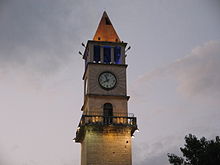
The symbol of the city is the equestrian statue in honor of Skanderbeg on the square of the same name . The Et'hem Bey Mosque (built from 1794 to 1821) and the 35 meter high clock tower from 1830 right next to it are also famous . Other remains from Ottoman times are rare. The Ottoman stone arch bridge Ura e Tabakëve from the 18th century with the mosque of the same name and the walls of the castle, some of which even date from the Justinian era , have been preserved. The Kapllan-Pascha-Türbe as well as the Kokonozi Mosque and the Sheikh Dyrri Tekke are part of the Ottoman cultural heritage.
One of the most important sights in the area around Tirana is the Petrela fortress on the road to Elbasan, which was built in the early Byzantine period . Another important fortress is in Preza .
In the 1930s and 1940s, the main university building and an ensemble of administrative buildings were built in the style of Italian fascism . The beautiful city villas, which were also built during this period, have largely had to give way to modern high-rise buildings in recent years. Building land is scarce and expensive in downtown Tirana.
The former Enver Hoxha Museum known as Piramida is located south of the Lana ; it is a communist-era building that opened in 1988 as a museum dedicated to dictatorial leader Enver Hoxha . His daughter Pranvera had the pyramid planned and built. Today the building is used for conferences and trade fairs; it is also the seat of the television broadcaster Top Channel .
architecture
The architecture is partly Balkan- traditional, partly from the interwar period fascist ( neoclassical ), but for the most part by prefabricated buildings , newer apartment houses and - especially in the northwest - by illegal settlements. Tirana has been experiencing an economic boom for several years; the many construction activities are evidence of this.
The facades of entire streets in the city center were redesigned a few years ago in flashy colors and wild patterns. Through these "painting actions" by the mayor and artist Edi Rama , the communist dreariness that was attached to many prefabricated buildings and many unplastered houses was alleviated. Other cities in Albania also adopted this idea from Tirana.
Since these first redesigns at the beginning of the 21st century, however, the cityscape has continued to change significantly. Modern new buildings, new avenues, schools, streets, cycle paths, parks and a new sewage system have emerged, and the supply of electricity and water has also improved a lot.
Downtown
The center of the city is Skanderbeg Square , which is home to the National History Museum , the Tirana International Hotel , the Palace of Culture , the Et'hem Bey Mosque and the clock tower behind it and the TID Tower , the ensemble of buildings from the fascist era - to the west of which there are still the puppet theater , the headquarters of the Socialist Party and the Albanian Orthodox Resurrection Cathedral - and the Bank of Albania is circled (turning clockwise from the north).

|
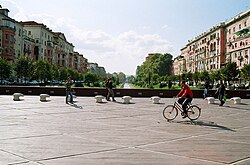
|
|
|
TID Tower on Skanderbeg Square
|
Pedestrian bridge over the Lana, connection to the Blloku district
|
From Skanderbeg Square, the city's main streets go in a star shape in all directions. The Boulevard Dëshmorët e Kombit is the central axis and leads south to the Ministry of Interior and Defense, the Rinia Park , the National Art Gallery , the Hotel Dajti , across the Lana , to the Pyramid of Hoxha , the Park Lulishtja e tre vëllezërve Frashëri , the Twin Towers , on past the Council of Ministers, the seat of government, the Rogner Hotel , the Qemal Stafa Park , the President's seat and the Congress Palace to Mother Teresa Square with the University , the Polytechnic University and the University of the Arts as well as the somewhat set back Qemal-Stafa-Stadion . To the north of the stadium is the ABA business center and south of it the Sheraton Hotel at the foot of the small hill on which the Great Park ( Parku i madh ) is located. There is a German military cemetery in the park . The botanical and zoological gardens are also located behind the artificial lake .
The Blloku, west of the central boulevard, was a residential area that was only inhabited by higher- ranking politicians , including Enver Hoxha , before the democratic change . In recent years, numerous cafés, trendy bars, chic restaurants, boutiques, office buildings and high-rise buildings such as the Sky Tower with a revolving restaurant have been built here in a very small space . The neighborhood is now often referred to as the playground of the young elite .
Further to the west is the Komuna e Parisit district with numerous modern high-rise buildings and the Selman Stërmasi Stadium .
In addition to numerous green spaces in the city center, the Great Park south of the university invites you to linger. It borders the artificial lake, next to which there is also the municipal swimming pool. In the past, the park was home to Shën Prokopi's Orthodox Church . The atheist communists issued a total ban on religion in 1967 - a restaurant was built on the site of the church. After the introduction of democracy, the building was converted back into a church.
To the east of the boulevard on the north bank of the Lana is the Catholic St. Paul's Cathedral (alb. Shën Pali ). Further east there is an old Ottoman stone bridge that spans the Lana ( Ura e Tabakëve ). The city's largest food market, Pazari i ri , is located east of Skanderbeg Square around Avni Rustemi Square .
To the northwest of Skanderbeg Square is Sheshi Karl Thopia (formerly Sheshi Zogu i Zi ), where the highways to Durrës and Shkodra begin.
From the central Skanderbeg Square to the north, the Boulevard Zogu I leads , which is lined with many boutiques and restaurants. The street ends at Sheshi Franc Nopca Square , where the Tirana train station of Hekurudha Shqiptare used to be . An extension to the north is currently (2014) being worked on.
Outskirts
The largest hospital in Albania, the Spitali Ushtarak - "Military Hospital " - is located in the district of Lapraka in northwest Tirana . The university hospital is located next to the "Skanderbeg" military academy northeast of Skanderbeg Square.
In the extreme south-western corner of the city is the Kombinati district , a formerly large industrial area with many factories and businesses and many residential buildings for the workers.
The Mother Albania ( Nëna Shqipëri ) monument is located on the Heroes' Cemetery on the southeastern outskirts of the city .
Sports
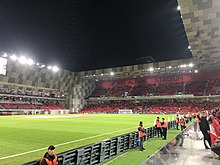
The three football club KF Tirana , KS Dinamo Tirana and FK Partizani Tirana among the most successful clubs in the country: Tirana tops the list of champions of the Albanian Cup against Dinamo and Partizani Kategoria Superiore on. Tirana and Partizani have won the trophy the most, ahead of Dinamo. Currently only KF Tirana and Partizani play in the top division. The football teams play their home games in the Selman Stërmasi Stadium and in the Air Albania Stadium , the national stadium .
For indoor sports such as basketball and volleyball , Tirana has the larger Pallati i Sportit "Asllan Rusi" arena , which served as refugee accommodation during the Kosovo war in 1999. The large outdoor pool on the outskirts, which was renovated and is now the largest outdoor swimming pool in Albania, was also used at the time.
folklore
Tirana has a rich traditional folklore that is popular across Albania. The city is one of the centers of central Albanian music, songs, dances and costumes. Famous interpreters of the typical folk music of Tirana include Merita Halili , Manjola Nallbani , Valbona Mema , Hafsa Zyberi (1925–1994) and Fitnete Rexha (1933–2003).
The musical style of the local folk culture is mainly characterized by the sounds of the clarinet and the accordion as well as the rhythm of Dajre and Tupan . In the entire central Albanian region around Durrës , Kavaja , Kruja and Elbasan , very similar musical styles prevail.
Every year on March 14th, the pagan spring festival Dita e Verës is celebrated in various streets and in numerous squares of Tirana.
Politics and administration
executive
The mayor of the Bashkia of Tirana (Albanian Kryetari i Bashkisë ) takes on executive functions together with his “cabinet” and is elected directly with the city council every four years. The mayor's seat is in the town hall on Skanderbeg Square.
Erion Veliaj ( PS ) has been the city's mayor since summer 2015 . He replaced Lulzim Basha ( PD ) , who had been in office since 2011 . Basha's predecessor was Edi Rama (PS) from 2000 to 2011 , who generated worldwide attention through numerous campaigns. Further predecessors after the fall of the communist regime were Sali Këlmendi (1992–1996) and Albert Brojka (1996–2000), both from the PD.
| person | from | to | person | from | to | person | from | to | ||
|---|---|---|---|---|---|---|---|---|---|---|
| Zyber Hallulli | 1913 | 1914 | Qemal Butka | 1936 | 1937 | Erion Veliaj | 2015 | today | ||
| Serve Libohova | 1915 | 1916 | Abedin Nepravishta | 1937 | 1939 | |||||
| Ismail Ndroqi | 1917 | 1922 | Qazim Mulleti | 1939 | 1940 | |||||
| Ali Begeja | 1922 | 1923 | Omer Fortizi | 1940 | 1943 | |||||
| Ali Derhemi | 1923 | 1924 | Halil Meniku | 1943 | 1944 | |||||
| Xhemal Kondi | 1924 | 1925 | none | 1944 | 1991 | |||||
| Fuat Toptani | 1925 | 1927 | Tomor Malasi | 1991 | 1992 | |||||
| Izet Dibra | 1927 | 1928 | Sali Kelmendi | 1992 | 1996 | |||||
| Rasim Kalakula | 1928 | 1930 | Albert Brojka | 1996 | 2000 | |||||
| Rexhep Jella | 1930 | 1933 | Edi Rama | 2000 | 2011 | |||||
| Abedin Nepravishta | 1933 | 1935 | Lulzim Basha | 2011 | 2015 |
legislative branch
The city council (alb. Këshilli Bashkiak ) consists of 61 members. He has legislative functions and is directly elected every four years by the voters of the Bashkia Tirana. The council seat is located on Skanderbeg Square.
Since 2015 , two coalitions have determined the council's policy: the left Alliance for European Albania (ASHE) under the leadership of the Socialist Party (ruling party since 2013 ) and the right People's Alliance for Work and Dignity (APPD) under the leadership of the Democratic Party . The distribution of seats in the Council is as follows:
| Political party | coalition | Number of council seats | |
|---|---|---|---|
| Socialist Party of Albania | ASHE | 25th | |
| Democratic Party of Albania | APPD | 17th | |
| Socialist movement for integration | ASHE | 13 | |
| Party for Justice, Integration and Unity | ASHE | 3 | |
| Albanian Republican Party | APPD | 1 | |
| New democratic wind | ASHE | 1 | |
| Party Movement for National Development | APPD | 1 |
Judiciary
Tirana is the seat of a district court (alb. Gjykata e Rrethit Gjyqësor ) and the Supreme Court of Albania (alb. Gjykata e Lartë e Republikës së Shqipërisë ). The Tirana Court of Appeal (alb. Gjykata e Apelit ), the Constitutional Court , the High Judicial Council and the Public Prosecutor's Office are also located.
City arms
The city coat of arms of Tirana shows a spade-shaped shield, which shows the clock tower of Tirana on a red background on the left and the coat of arms of the medieval local noble family of the Skuraj on a blue background on the right . The top of the shield is closed off by a three-tower wall crown.
Town twinning
|
economy
Tirana was a focus of industry in Albania during the communist rule. There was mechanical engineering, shoe and textile industries, a cement factory, glass processing and food industries. As in the rest of the country, most of the industrial plants have now been shut down. Most of the residents now work in commerce, industry, government, construction, and services.
Many, especially foreign, companies that operate in the country are headquartered in the capital. The Central Bank of Albania , Raiffeisen Bank Albania , Banka Kombëtare Tregtare , American Bank of Albania, Credins Bank and Tirana Bank have their headquarters in the Albanian metropolis. The three telecommunications providers Albanian Mobile Communications (AMC), Vodafone Albania and Telekom Albania are also based here. The airlines of Albanian Airlines and Belle Air were also based here until they went bankrupt.
In the 21st century - especially along the main road to Durrës - several shopping centers and department stores, including the Qendra Tregtare Univers , the Citypark and the Tirana East Gate , the largest in Albania, were built.
In Tirana too, as in the whole of Albania, tourism has increasingly gained influence on the economy. Many professionals are employed in this sector. The largest hotels in the country are also located in the capital, such as the Tirana International Hotel , the Hotel Rogner and the now closed Hotel Sheraton and Hotel Dajti .
media
The largest TV channels, radio stations, newspapers and magazines in Albania have their headquarters in Tirana. 1938 came with the sentence Mirëdita, kjo është Radio Tirana. (Hello, this is Radio Tirana.) The first Albanian radio station, Radio Tirana, on the air. In 1960 the first television program from Radio Televizioni Shqiptar followed . Between 1945 and 1990/91, however, the media were controlled by the state during the dictatorship and so did not allow freedom of the press. The signals from the neighboring Italian, Yugoslav and Greek radio stations were often suppressed.
After the fall of the dictatorship and the initiation of the transformation process in politics, society and the economy, the media landscape grew rapidly. Private television and radio stations and the first independent newspapers came into being for the first time. This all took place in Tirana, which made it the center of Albanian independent media pioneers.
The largest television stations today include the public broadcaster TVSH , the private, more left-wing channel Top Channel , the private, more right-wing channel TV Klan , the private channels Vizion Plus and Albanian Screen Radio Television and other smaller news channels.
The radio stations Top Albania Radio , Radio Tirana 2 , Club FM , Radio Dee-Jay and Boom Boom Radio are also headquartered in Tirana and have one of the most popular radio programs in Albania.
Shqip , Koha Jonë , Panorama , Shekulli , Tirana Observer and Tirana Times are among the most important Albanian daily newspapers. Mapo magazine has the highest circulation in Albania and is also headquartered in Tirana.
Transport infrastructure
Located in the center of the country, the Tirana-Durrës area forms the hub of the Albanian transport network. Since the 2000s, Albania's road network has been renewed and expanded - investments have also been made in the city center in recent years so that the roads can cope with the sharp increase in traffic and the needs of local public transport are better covered. The country's only international airport near the capital has also been modernized and expanded. Rail transport has been neglected in the last few decades, even if there are expansion plans.
Road traffic
In particular, the access roads from Durrës and Elbasan have been expanded and expanded in recent years, while renovations in the city center around Skanderbegplatz should make traffic more fluid. The city center has been relieved of through traffic with new bypass roads in the west and south. The southwest bypass, which enables a continuous connection from the SH2 to the A3 outside the city center, was completed in September 2017. Other parts of the bypass are being planned or already under construction in the southeast.
Many parts of the country are directly connected to the capital by national roads. The SH1 runs from the Montenegrin border via Shkodra , Lezha and Fushë-Kruja to Tirana and is thus part of the nationally important north-south axis. The SH2 is the direct connection with Durrës , the most important port city in Albania. The SH3 is currently being expanded to form the A3 motorway, which connects Tirana with Elbasan and, as Pan-European Transport Corridor VIII, provides a connection to the North Macedonian border and via Korça to Greece . Apart from a short section, the A3 was passable on at least one lane in summer 2017. An extension from Elbasan via Berat to Tepelena in southern Albania is planned.
The construction of the A1 shortened the travel time from Tirana to Kosovo by many hours. Today you can reach Pristina in less than three hours, which brings the markets of Albania and Kosovo closer together.
Rail transport
The Durrës – Tirana railway was opened in 1949.
The Hekurudha Shqiptare operated direct rail connections from Tirana to Durrës, Shkodra, Elbasan and Vlora for decades. In 2013, however, the section from Tirana to Vora was discontinued as the Tirana train station is to be relocated to the outskirts to make way for a new boulevard and a new district. Replacement buses occasionally ran between Tirana and Vora. The trains are currently ending in the Kashar district. Construction work for the new train station and bus terminal Terminal i transportit publik Tirana did not begin until 2020.
Air traffic
Tirana International Airport Nënë Tereza is located 17 kilometers to the northwest . It is the only civil airport in Albania. There are regular connections to various cities in Italy, Germany, Austria, Slovenia, Greece and Turkey. In 2012 almost 1.7 million passengers used the airport.
Public transport
Public transport within Tirana is handled exclusively by public bus routes. There are lines from Skanderbeg Square to the outer quarters and a ring line that circles the center in both directions. In 2010 new buses were purchased by the city administration. In addition, some bus lanes have been set up in recent years so that buses are less likely to get stuck in traffic jams. Public transport is to be made more attractive with additional bus lanes.
There are daily buses from Tirana to all major cities in the country and also to major cities in Europe.
At the planned new Terminal i transportit publik Tirana station in the north of the city, a traffic junction between local and long-distance public transport is to be created. In addition to the railway, a bus station is to serve the inner-Albanian traffic. A streetcar (trami) will in future provide connections to the city . Two tram lines are planned: One from the train station to the university, which crosses the city center from north to south, and a second route, which runs from the suburb of Dajt in the east across Tirana to the outlying district of Kombinat in the west. The start of construction of the tram is uncertain.
Dajti Ekspres
Since the summer of 2005 brings gondola Dajti Ekspres visitors in a short time on the mountain Dajti . The railway, built by an Austrian company, offers a quick and convenient alternative to the narrow and winding mountain road. The popular destination offers a wide view of the city and the surrounding area.
Cycle
Cycle lanes are being set up on more and more streets.
The Ecovolis bike rental system was launched in 2011. Bicycles can be rented at several stations for a small fee.
education
The Albanian Academy of Sciences and several state universities have their headquarters in Tirana , including the state universities of the University of Tirana , the oldest university in Albania, the Polytechnic University located in the distinctive building on Mother Teresa Square , the Tirana University of Medicine , the University of the Arts (formerly the Art Academy ), the Sports University and the Agricultural University of Tirana in the suburb of Kamza . In addition, numerous private universities have opened since the year, many with melodious names such as University of New York Tirana (founded in 2002), European University of Tirana , the Albanian University ( UFO University until 2010 ) and Kristal University (closed by the Ministry of Education in 2014) . Other private universities include the Muslim Bedër University , the Catholic University “Maria, Mutter vom Guten Rat” , the Epoka University , the Polis University with a focus on design, urban planning and architecture and the Marubi Academy for film and multimedia .
There are state and private kindergartens, 9-year schools (elementary schools) and middle schools throughout the city. Foreign educational institutions such as the French Epitech and the Goethe Institute as well as Alliance française are also represented.
environment
The municipal garbage disposal functioned only to a limited extent after 1990, which is why garbage was often disposed of illegally. In the meantime, however, the infrastructure has improved in terms of waste disposal and city cleaning, as the city administration and government have carried out many projects in recent years to limit the enormous pollution. Last but not least, numerous volunteer campaigns in which committed citizens collect rubbish or plant trees also help to improve the environmental situation. For example, the Lana is now more or less clean and free of waste.
Recently, the new mayor, Erion Veliaj , who wants to make Tirana the “cleanest city in the Balkans ”, has been increasingly committed to the environment. So he creates new green spaces and has given cleaning companies an ultimatum: Either they work efficiently or their contract with the city is terminated. He also imposed very heavy fines for throwing rubbish on the streets, urinating in public and other vandalism .
Air pollution remains a problem. Although the measured values for ozone , sulfur and nitrogen dioxide do not exceed the EU limit values, the values for fine dust in the air are questionable: Although the annual mean value approved by the EU should not exceed 40 µg / m³, in the southern inner city up to 65 µg / m³ measured. The measured values exceeded the limit value at certain locations more than 100 times a year, which according to the EU should only occur 40 times.
Noise pollution has decreased since 2007, but remains high. In the Rruga e Elbasanit, for example, the value 74.3 dB (per day) was determined, whereby the approved value of the EU is 55 dB (per day).
Personalities
literature
- Wilfried Heller (Hrsg.): Emigration area Albania - Immigration destination Tirana . (= Practice cultural and social geography. 27). Universitäts-Verlag, Potsdam 2003, ISBN 3-935024-68-1 .
- Beat Bieri: Tirana in color . Velvet-Edition, Lucerne 2003 (photo book about the action of the city to paint the houses in bright colors, as well as interview with the mayor Edi Rama).
- Dietmar Richter: Land use change in Tirana. Investigations using Landsat TM, Terra ASTER and GIS. (= Practice cultural and social geography. 42). Universitäts-Verlag, Potsdam 2007, ISBN 978-3-939469-64-3 (full text)
- Adolph Stiller (Ed.): Tirana. Plan, Build, Live . (= Architecture in the Ringturm. Volume 22). Müry Salzmann Verlag, Salzburg 2010, ISBN 978-3-99014-030-7 .
Web links
- Official website of the city administration
- The rebirth of the city - the city administration shows pictures of painted houses, new parks and streets
- Tirana-Online.de - tourist information about Tirana (German, Albanian)
- Information about Tirana as part of the New Economic Geography Map of the European Stability Initiative (ESI )
- Interactive map of Tirana
Individual evidence
- ↑ a b c d Ines Nurja: Censusi i popullsisë dhe banesave / Population and Housing Census - Tiranë 2011 . Results Kryesore / Main Results. Ed .: INSTAT . Pjesa / Part 1. Adel Print, Tirana 2013 ( instat.gov.al [PDF; accessed on November 5, 2019]).
- ↑ a b Statistics 2009 (9-mujori). (PDF) Retrieved April 30, 2010 .
- ↑ “Mushkeria” e Tiranes, drejt betonizimit. Koha Jonë , archived from the original on July 23, 2010 ; Retrieved October 25, 2012 (Albanian).
- ↑ Njësitë bashkiake - Kryetarët dhe kompetencat. Bashkia Tirana, archived from the original on December 8, 2012 ; Retrieved November 8, 2012 (Albanian).
- ↑ Bashkia Tirana - Njësitë Administrative. Retrieved November 5, 2019 (Albanian).
- ↑ a b c Cay Lienau: Geographical Basics . In: Klaus-Detlev Grothusen (Hrsg.): Albanien (= Südosteuropa-Handbuch . Volume VII ). Vandenhoeck & Ruprecht, Göttingen 1993, ISBN 3-525-36207-2 , pp. 7-9 .
- ↑ Santi Qirko: Microclimate in hot humid regions: A case study of Tirana. Academia.edu , accessed on January 23, 2020 .
- ↑ Elke Gauder, Barbara Schlemann, Annette Berning, Cay Lienau: At geology, surface morphology, climate and vegetation of Albania . In: Cay Lienau, Günter Prinzing (Ed.): Albania - Contributions to geography and history . Publishing house Dr. Cay Lienau, Münster 1986, ISBN 3-9801245-0-9 , p. 139 .
- ↑ a b Kristo Frashëri: Tirana; a Brief Historic Overview . In: Besnik Aliaj, Keida Lulo, Genc Myftiu (eds.): Tirana - The Challenge of Urban Development . Cetis, Tirana 2003, ISBN 99927-880-0-3 , pp. 140 f .
- ^ Armanda Hysa: The History, Form and Function of the Old Bazaar in Tirana . In: Andreas Hemming, Gentiana Kera, Enriketa Pandelejmoni (eds.): Albania: family, society and culture in the 20th century (= Studies on South East Europe ). tape 9 . LIT, Zurich 2012, ISBN 978-3-643-50144-8 , p. 207-217 .
- ↑ Themelimi i Tiranës (foundation Tiranas). Official homepage of Bashkia Tirana, archived from the original on March 2, 2013 ; Retrieved February 3, 2013 (Albanian).
- ↑ Albania: More than 100 injured in earthquakes. In: Tagesschau. September 22, 2019, accessed September 22, 2019 .
- ↑ Dozens of people injured after a series of earthquakes in Albania. In: The Standard. September 21, 2019, accessed September 22, 2019 .
- ↑ Development of the population in Albania
- ↑ Nadia Pantel: Balancing in Tirana. In: Jetzt.de - Süddeutsche Zeitung. January 2, 2015, accessed January 4, 2015 .
- ↑ Gëzim Hoxha, Bashkim Lahi: Islamic Art and Architecture . In: Werner Daum (Ed.): Albania - between cross and crescent . Pinguin Verlag, Innsbruck 1998, ISBN 3-7016-2461-5 , p. 146 .
- ↑ Prolegomena on a saint history of Albania (PDF; 99 kB)
- ↑ About Tirana ( Memento from November 15, 2010 in the Internet Archive )
- ↑ Anëtarët të Këshillit Bashkiak (City Council members). In: Bashkia Tirana. Retrieved March 9, 2014 (Albanian).
- ↑ Qatar, Basha nënshkruan marrëveshje binjakëzimi mes Tiranës s Doha (Qatar, Basha signing twinning between Tirana and Doha). In: Time.ikub.al. February 12, 2012, accessed March 9, 2014 (Albanian).
- ↑ Bashkia e Tiranës binjakëzohet me bashkinë e Kabulit. In: Gazeta 55. December 3, 2009, archived from the original on March 4, 2016 ; Retrieved March 9, 2014 (Albanian).
- ↑ Basha takon homologun grek Jorgos Dhrikos. In: Tirana Observer. February 27, 2014, accessed March 9, 2014 (Albanian).
- ↑ Tirana binjakezohet me Pekinin. In: Koha Jonë. March 22, 2008, Retrieved October 6, 2019 (Albanian).
- ↑ Comune di Verona - Grandi Eventi - Gemellaggi e Patti d'Amicizia . Retrieved May 3, 2018.
- ↑ Trami. In: Bashkia Tirana. Retrieved September 16, 2013 (Albanian).
- ↑ ChannelOneAl: Pastrimi në Tiranë. Veliaj: Do të rishikohen kontratat me kompanitë. August 3, 2015, accessed April 29, 2016 .
- ↑ Shqiptarja.com - Bashkia Tiranë: 200 mijë lekë gjobë kush hedh plehra në rrugë. In: Shqiptarja.com. Retrieved April 29, 2016 .
- ↑ Raporti për gjendjen e mjedisit 2014. (PDF (80.5 MB)) Albanian Ministry of the Environment, p. 16 f. , archived from the original on February 7, 2016 ; Retrieved April 30, 2016 (Albanian).
- ↑ Raporti për gjendjen e mjedisit 2014. (PDF (80.5 MB)) Albanian Ministry of the Environment, p. 36 , archived from the original on February 7, 2016 ; Retrieved April 30, 2016 (Albanian).



